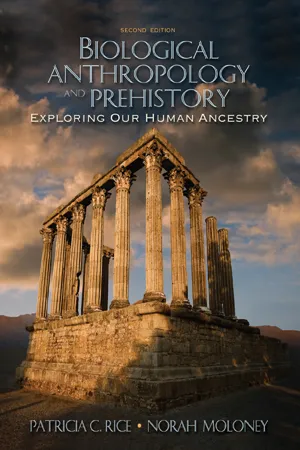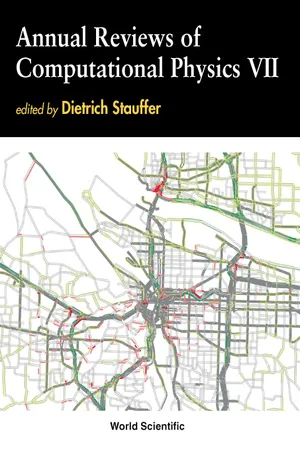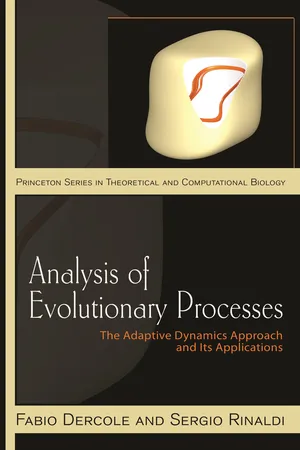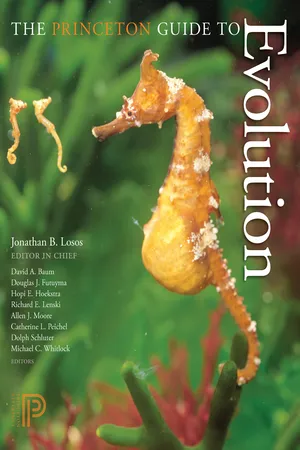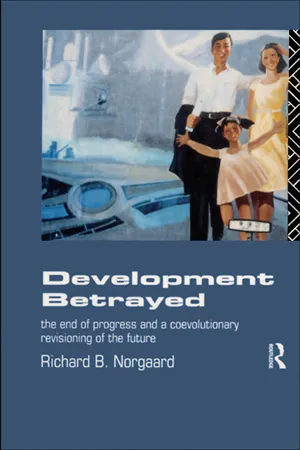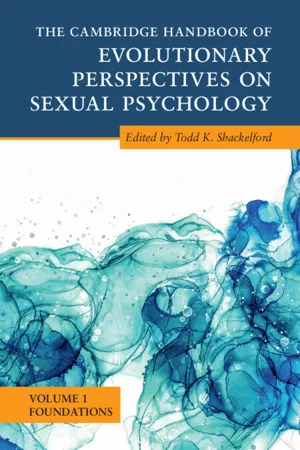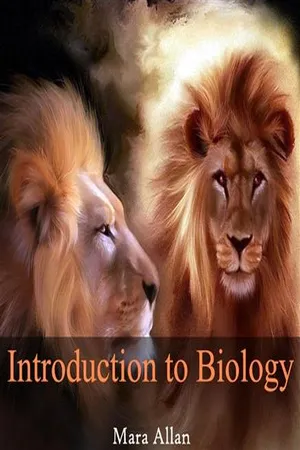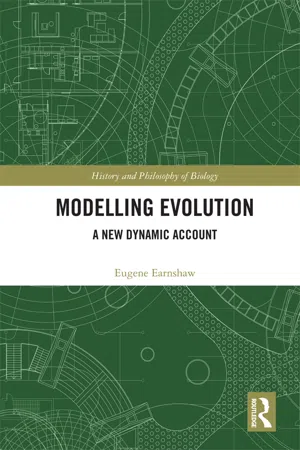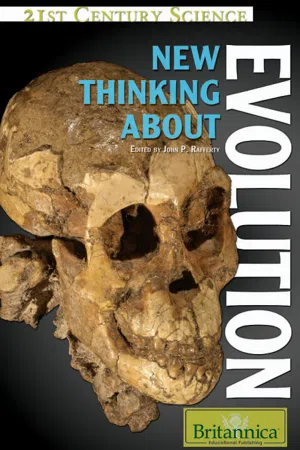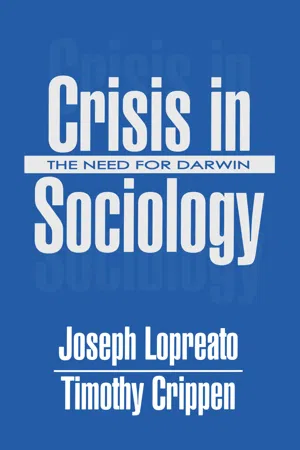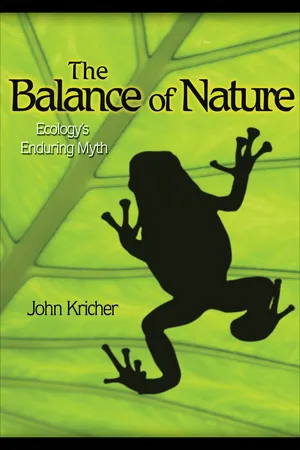Biological Sciences
Evolution process
The evolution process refers to the gradual change in the genetic makeup of a population over successive generations. It is driven by mechanisms such as natural selection, genetic drift, mutation, and gene flow, leading to the adaptation of organisms to their environments and the emergence of new species. This process is fundamental to understanding the diversity of life on Earth.
Written by Perlego with AI-assistance
Related key terms
1 of 5
12 Key excerpts on "Evolution process"
- eBook - ePub
Biological Anthropology and Prehistory
Exploring Our Human Ancestry
- Patricia C. Rice, Norah Moloney(Authors)
- 2016(Publication Date)
- Routledge(Publisher)
evolution is still “biological change through time.” Fleshed out a bit, biological evolution is the process by which ancestral populations accumulate morphological and genetic changes to become more modern populations. Given this definition, biological evolution is fact, not hypothesis or theory, because change can often be observed.For example, controlled experiments with fruit flies show the fact of evolution. If a fruit fly population is left alone in a cage with banana mush but no human manipulation, experimenters can compare two generations of fruit flies morphologically (in terms of outer appearance), inferring their genetics, for signs of change. Geneticists traditionally use fruit flies because some of their chromosomes are large and easily observed, and generation length is a mere two weeks. Variations in such observable traits as wing size (long, medium, short, or just nubbins) or eye color (red or white) can be counted for the first generation and recounted when the second generation takes its place, and simple proportions compared. The proportions will probably not be exactly the same. If the populations are numerically large, mutations or selection may alter the counts slightly; a single mutation, for example, can change wing size to nubbins in the mutated individual. If the populations are numerically small, chance will probably alter the counts. In any case, when a new population has changed biologically through time, it has, by definition, evolved. This change can be observed and measured. After five or six generations of fruit fly evolution, again with no human manipulation beyond feeding and removing dead flies, patterns of evolution can be established and causes hypothesized for the accumulated change. We will explore evolutionary causes later in this chapter.Other lines of support, too, point to evolution as fact. First, the fossil record shows many different kinds of support for evolution. Scientists trace entire lineages by documenting succeedingly older and older fossils, demonstrating that change is occurring over time. Second, many cases of natural selection can be documented in nature. Such cases show how differential success in reproduction in a population results in differences in morphology and genetics in subsequent generations. Third, on the molecular level, humans are said to share 98.7 percent of both their structural genes and DNA with chimpanzees and bonobos. This argues strongly for a common ancestor of those three modern species in the not-too-distant past (Marks 2000a, 2000b). On the other hand, both humans and apes share a lot of their DNA with bananas as well (Marks 2000a)! The fact that all life - eBook - PDF
- Dietrich Stauffer(Author)
- 2000(Publication Date)
- World Scientific(Publisher)
But first of all, we must define our subject more precisely. Evolution proceeds via mutation and selection. In this shortened version, the understanding of biological evolution has entered everyday knowledge. Of course, it's too short to be correct: actually, evolution consists of a fair number of elementary processes, i.e. mutation, selection, recombination, migration, and drift (i.e. fluctuations due to finite population size), and it is not even Biological Evolution Through Mutation, Selection, and ... 205 decided whether mutation and selection are the most important ones. They are, however, weighty factors, and may serve as a case study of evolution as such. For the conceptual issues related to the notion of evolution, we refer the reader to Endler. 40 We shall restrict ourselves to models of mutation and selection, without and with genetic drift. That is, we must — regrettingly — exclude the fas-cinating topic of recombination, and, with it, the evolution and maintenance of sexual reproduction. Fortunately, there is a recent review available on this topic. 43 But due to finite time, space, and knowledge of the authors, the field must be narrowed down even further. We shall concentrate on models which describe genetic variation within single populations. This excludes macroevo-lution, speciation, and phylogeny (which are concerned with variation between populations), as well as adaptive walks (which describe species as genetically homogeneous entities). For the same reasons, models of coevolution will not be considered here. For a simple model of interacting populations, we refer to Bagnoli and Bezzi (this volume). In order to provide the uninitiated with some flavour of the field, we will set out with a few relevant questions before embarking on the basic models of population genetics. The latter describe the evolution of the composition of a population under the joint action of mutation, selection, and drift, and will provide the foundations on which to build. - eBook - PDF
- Loren E. Babcock(Author)
- 2012(Publication Date)
- Wiley(Publisher)
140 ■ Phylogenetics: Reconstructing Evolutionary History p. 143 ■ Evolutionary Patterns and Extinction p. 148 volution in organisms simply refers to change through time. That change can be thought of as occurring along a spectrum of scales. At the smallest scale, individual or- ganisms go through changes during their lifetimes. Such changes are usually regarded as ontoge- netic changes. Changes that occur within a species or pop- ulation from one generation to the next, as parents pass their morphologic, behavioral, and other traits on to their offspring, represent microevolution (Figure 5.1 ). Mi- croevolutionary processes are natural selection and genet- ics (mutation, genetic drift, and gene flow). Evolution at the species level, including changes that can be used to differentiate higher taxonomic groups, represent macroevolution (Figure 5.2). Macroevolutionary processes include speciation, changes in the tree of life (which comprises the genetic link among all life forms), and extinction. Microevolutionary and macroevolution- ary processes are interrelated, and both are pertinent to unraveling the story of Earth’s biotic history. The notion of evolution in life forms has a long scientific and philosophical history. More than 2,000 years ago, philosophers in ancient Greece discussed bio- logic evolution in general terms. During the Middle Ages, though, strict adherence to theologic teachings suppressed scientific efforts to understand the natural world, and the concept of special creation of life forms held sway among Europeans for a long time. In the 1700s and 1800s, the doctrine of fixity of species prevailed in scientific writing. According to this paradigm, plants and animals, which were the only major life forms recognized at the time, remained unchanged from the time of their first appearance on Earth. - eBook - PDF
Analysis of Evolutionary Processes
The Adaptive Dynamics Approach and Its Applications
- Fabio Dercole, Sergio Rinaldi(Authors)
- 2008(Publication Date)
- Princeton University Press(Publisher)
However, for tradition, simplicity, and uniformity, we will mainly refer throughout this chapter to biolog-ical evolution, pointing out here and there, and, in particular, in Section 1.9, the analogy with the evolution of social and economic systems. Later, in Chapter 4, we will interpret and analyze the process of technological change as an evolutionary process, where replicators are commercial products competing in a market, which replicate in production and transmit, with possible innovations, technological char-acteristics to new generations of products. Through a stylized model we will show that the evolutionary interpretation of technological change supports the emergence of technological variety from a single ancestral technology. In the next three sections we introduce the basic biological elements of evolution-ary processes, namely the structure of the genetic material and the laws of heredity, underpinning the way of being and reproducing of all living organisms, the appear-ance of mutations, ultimate source of organisms variability, and the mechanisms of selection of successful mutants. Among the innumerable options, we closely follow Charlesworth and Charlesworth (2003), a lucid and concise introduction to evolutionary theory, presenting some of their contributions in a form appropriate for this book. Sections 1.5–1.8 describe the evolutionary patterns we might expect to emerge as long-term consequences of evolutionary processes, while the last sec-tion shows many examples of such patterns in biological as well as nonbiological contexts. 1.2 GENOTYPES AND PHENOTYPES Starting with Mendel’s (1865) work and passing through the achievements of mod-ern molecular biology, we now know that the similarities between living organisms are not confined to visible structural characteristics, but are profound and extend to the smallest microscopic scale. - eBook - ePub
- David A. Baum, Douglas J. Futuyma, Hopi E. Hoekstra, Richard E. Lenski, Allen J. Moore, Catherine L. Peichel, Dolph Schluter, Michael C. Whitlock, David A. Baum, Douglas J. Futuyma, Hopi E. Hoekstra, Richard E. Lenski, Allen J. Moore, Catherine L. Peichel, Dolph Schluter, Michael C. Whitlock(Authors)
- 2013(Publication Date)
- Princeton University Press(Publisher)
IV Evolutionary Processes Michael C. Whitlock As the great population geneticist (and statistician) Sir Ronald Fisher said in the first sentence of his foundational Genetical Theory of Evolution, “Natural selection is not evolution.” A population evolves when the frequencies of its genotypes change over time. The most important of these changes are typically caused by natural selection, but selection is not the only mechanism by which evolution occurs. When alleles are passed from one generation to the next, the next generation may by chance not exactly match the generation of its parents, especially if the population size is small. Alleles can mutate to new alleles, and alleles can arrive by migration from genetically diverged populations. DNA sequences may recombine with genetically distinct sequences. The details of mating can matter, because genotype frequencies can change as a result of mating between relatives, mating between similar individuals, or mating with nearby individuals. All these factors—random genetic drift, mutation, migration, recombination, and nonrandom mating—can change the genotype frequencies in a population from one generation to the next; in other words, they can cause evolution. This section discusses these nonselective evolutionary processes and some of their important consequences. We start with a discussion of random genetic drift (see chapter IV.1). In a finite population, chance in part dictates which individuals happen to succeed and leave offspring; therefore, chance can cause the allele frequency to change from one generation to the next. This random process, called genetic drift, changes the allele frequency from one generation to the next. Such drift has greatest effect for alleles that have very small effects on fitness - eBook - ePub
Development Betrayed
The End of Progress and a Co-Evolutionary Revisioning of the Future
- Richard B Norgaard(Author)
- 2006(Publication Date)
- Routledge(Publisher)
average they were slow. And since no one had seen evolution in their lifetime, the process must have been slow. The directionality of evolution was clear since the physical niche is given. The gradualist explanation has been so effective in conveying the idea of evolution in the classroom and to the public generally that it has overridden our deeper understandings of the process. This common, simple explanation rules to such an extent that biologists themselves sometimes have to be reminded that our understanding of evolution was always more complex and has also evolved dramatically over the past three decades.When species evolve in response to changes in each other rather than a predetermined physical niche, all evolutionary direction is lost. Furthermore, when the selective forces themselves change, evolution and extinction are likely to occur at very uneven rates. Thus the dominant view among evolutionary theorists now is that groups of interacting species, at different times and places, have periods during which they share many characteristics which fit together. During these periods when traits have evolved such that they can be thought of as, metaphorically speaking, locked together, evolutionary change is slow. Locked together, the characteristics of each species in the group reflects the characteristics of the other species in the group. When locked, evolutionary change continues slowly. Periods of rapid evolution among a group of species, and changes in the composition of the group, can be initiated by the introduction of a genetic trait or species from another area or by a mutation in one species which proves fit. As the group becomes “unlocked”, criteria for fitness change significantly, and with new selection criteria, evolution can occur more rapidly. Whatever the source, the new fit characteristic of species, or the loss of characteristics or whole species, puts new selective pressures on the other species. When these new selective pressures are sufficient that they unlock the interactive fitness of the group, evolutionary change can be fast. Thus evolution is now thought of as occurring at widely varying rates, and sometimes quite quickly. - eBook - PDF
- Todd K. Shackelford(Author)
- 2022(Publication Date)
- Cambridge University Press(Publisher)
The rest of this chapter and several of those that follow will be dedicated to explaining how such a mindless process can result in the func- tionally complex and diverse life-forms we observe in nature. One important feature of natural selection – a feature common to all algorithms – is that it is substrate-neutral (Dennett, 1996). We are used to 6 anna g. b. sedlacek thinking of its operation on genes composed of deoxyribonucleic acid, but it can occur in any situation involving the three components listed above, from organisms on Earth to alien organisms to computer simulations – potentially even transmitted ideas (Dawkins, 2016b). However, since this handbook concerns sexual psychology, the remainder of this chapter will focus on natural selection of sexually reproducing organisms: reproduction that involves the union and recombination of genetic material from two organisms. Before explaining the concept of natural selection as it applies to organisms, several key biological terms must be defined. A crucial piece of information unavailable to Darwin when he articulated his theory of evolution by natural selection was the concept of genetic inheritance. Genes go by many definitions, but for the purposes of this chapter, it may be best to use Richard Dawkins’ definition of a gene as “any portion of chromosomal material that potentially lasts for enough generations to serve as a unit of natural selection” (Dawkins, 2016b, p. 36). Different variants of genes are called alleles. Biological evolution simply means change in allele frequencies within populations over successive generations (Forbes & Krimmel, 2010), though “evolution” is often used interchangeably with the theory of evolution by natural selection. An organism’s genotype – its complete set of genes that can be transmitted to offspring – is technically invisible to selection. Genes are inherited, but genes themselves are not traits. - No longer available |Learn more
- (Author)
- 2014(Publication Date)
- Learning Press(Publisher)
Indeed, the evolution of microorganisms is particularly important to modern evolutionary research, since their rapid reproduction allows the study of experimental evolution and the observation of evolution and adaptation in real time. Adaptation Adaptation is the process that makes organisms better suited to their habitat. Also, the term adaptation may refer to a trait that is important for an organism's survival. For example, the adaptation of horses' teeth to the grinding of grass. By using the term adaptation for the evolutionary process, and adaptive trait for the product (the bodily part or function), the two senses of the word may be distinguished. Adaptations are produced by natural selection. The following definitions are due to Theodosius Dobzhansky. 1. Adaptation is the evolutionary process whereby an organism becomes better able to live in its habitat or habitats. 2. Adaptedness is the state of being adapted: the degree to which an organism is able to live and reproduce in a given set of habitats. 3. An adaptive trait is an aspect of the developmental pattern of the organism which enables or enhances the probability of that organism surviving and reproducing. Adaptation may cause either the gain of a new feature, or the loss of an ancestral feature. An example that shows both types of change is bacterial adaptation to antibiotic selection, with genetic changes causing antibiotic resistance by both modifying the target of the drug, or increasing the activity of transporters that pump the drug out of the cell. Other striking examples are the bacteria Escherichia coli evolving the ability to use citric acid as a nutrient in a long-term laboratory experiment, Flavobacterium evolving a novel enzyme that allows these bacteria to grow on the by-products of nylon manufacturing, and the soil bacterium Sphingobium evolving an entirely new metabolic pathway that degrades the synthetic pesticide pentachlorophenol. - eBook - ePub
Modelling Evolution
A New Dynamic Account
- Eugene Earnshaw-Whyte(Author)
- 2018(Publication Date)
- Routledge(Publisher)
5 Evolution in the social sciencesChallenges
The specter of biologism
The view that the concepts of evolution by natural selection should in principle be applicable to broader domains than biology has been very widely held, beginning with Darwin. But enthusiasm for particular attempts to put this into practice has been rather less comprehensive. There is no major domain outside biology where an evolutionary paradigm is widely accepted, let alone forms the basis for the discipline. Evolutionists at best form well-known but marginal subgroups in the social sciences, whether it is in economics, anthropology, psychology, or the history of technology.In the evolutionary social sciences there is no set of agreed upon concepts, models, or methods. Different authors take different aspects of evolutionary theory to be central. Mokyr (1992, 2002) focuses on the distinction between phenotype and genotype. Basalla (1988) takes gradualism to be fundamental. Campbell (1960) emphasizes the role of blind variation. For Dawkins (1976) and Blackmore (2000) the notion of replication is indispensable. Hull et al. supplement replication with repeated cycles of variation (2001). Aldrich et al. drop replication for conservation of information under resource scarcity (2008). Nelson and Winter (1982) construct their models around mechanisms analogous to selection and mutation. Richerson and Boyd (2005) emphasize processes distinct from those found in biology, supplementing natural selection with various forms of biased transmission specific to human culture. Andersen (2004) gives the Price equation a central role in a view otherwise similar to Hull et al.The attempt to decipher which of these approaches are sensible and which are confused is rendered problematic due to the tendency of most philosophical accounts of evolution to narrowly address biological situations. While this narrowness is perfectly understandable given the historical origins and pragmatic use of evolutionary theories, it has led to problems. I refer to this characteristic limitation of evolutionary accounts as ‘biologism’, a bias that colours the vast majority of writings on the topic. Its consequence is distorted understandings of evolution that are tied to a narrowly biological conception of evolutionary processes. - eBook - ePub
- Britannica Educational Publishing, John P Rafferty(Authors)
- 2010(Publication Date)
- Britannica Educational Publishing(Publisher)
Natural selection refers to any reproductive bias favouring some genes or genotypes over others. Natural selection promotes the adaptation of organisms to the environments in which they live; any hereditary variant that improves the ability to survive and reproduce in an environment will increase in frequency over the generations, precisely because the organisms carrying such a variant will leave more descendants than those lacking it. Hereditary variants, favourable or not to the organisms, arise by mutation. Unfavourable ones are eventually eliminated by natural selection; their carriers leave no descendants or leave fewer than those carrying alternative variants. Favourable mutations accumulate over the generations. The process continues indefinitely because the environments that organisms inhabit are forever changing. Environments change physically—in their climate, configuration, and so on—but also biologically, because the predators, parasites, competitors, and food sources with which an organism interacts are themselves evolving.Mutation, gene flow, and genetic drift are random processes with respect to adaptation; they change gene frequencies without regard for the consequences that such changes may have in the ability of the organisms to survive and reproduce. If these were the only processes of evolutionary change, the organization of living things would gradually disintegrate. The effects of such processes alone would be analogous to those of a mechanic who changed parts in an automobile engine at random, with no regard for the role of the parts in the engine. Natural selection keeps the disorganizing effects of mutation and other processes in check because it multiplies beneficial mutations and eliminates harmful ones.Natural selection accounts not only for the preservation and improvement of the organization of living beings but also for their diversity. In different localities or in different circumstances, natural selection favours different traits, precisely those that make the organisms well adapted to their particular circumstances and ways of life.The parameter used to measure the effects of natural selection is fitness, which can be expressed as an absolute or as a relative value. Consider a population consisting at a certain locus of three genotypes: A 1 A 1 , A 1 A 2 , and A 2 A 2 . Assume that on the average each A 1 A 1 and each A 1 A 2 individual produces one offspring but that each A 2 A 2 individual produces two. One could use the average number of progeny left by each genotype as a measure of that genotype’s absolute fitness and calculate the changes in gene frequency that would occur over the generations. (This, of course, requires knowing how many of the progeny survive to adulthood and reproduce.) Evolutionists, however, find it mathematically more convenient to use relative fitness values—which they represent with the letter w —in most calculations. They usually assign the value 1 to the genotype with the highest reproductive efficiency and calculate the other relative fitness values proportionally. For the example just used, the relative fitness of the A 2 A 2 genotype would be w = 1 and that of each of the other two genotypes would be w = 0.5. A parameter related to fitness is the selection coefficient, often represented by the letter s , which is defined as s = 1 − w . The selection coefficient is a measure of the reduction in fitness of a genotype. The selection coefficients in the example are s = 0 for A 2 A 2 and s = 0.5 for A 1 A 1 and for A 1 A 2 - eBook - ePub
Crisis in Sociology
The Need for Darwin
- Joseph Lopreato, Timothy Crippen(Authors)
- 2018(Publication Date)
- Routledge(Publisher)
the mechanism , even cause, of evolution. Technically, however, the causes and mechanisms of evolution are aspects of genotype and environmental pressures, including behavior (see Sober 1984 for a thorough discussion of issues surrounding the natural selection concept). There is a crucial lesson in this fact, at least for sociologists and other recalcitrant social scientists. There are two fundamental orders of causes in evolution, and in behavior: one is genetic in nature; the other is environmental, and it includes the cultural. It follows that all talk of “biological determinism,” which verges on the epidemic among sociologists, is sheer poppycock and reveals an intellectual lacuna that with the years has become a huge impediment to cross-disciplinary fertilization.Sexual Selection
The struggle for existence may take various forms, and may be observable in various contexts. The members of a given population may, for example, have to struggle in the face of a dire scarcity of water, or may be in competition with members of another population for a given source of nourishment. In both cases, the ultimate result is a process of natural selection, that is, differential reproductive success. But, as has been suggested, Darwin was a little fuzzy about the meaning of natural selection. Strictly speaking, the above equation of natural selection with differential reproduction refers to a clarification that subsequent evolutionists have effected to better make sense of Darwin’s theory. Darwin himself tended to focus on survival as longevity or, viewed from the reverse perspective, on prereproductive death. This view tended to underestimate the fact that what counts for evolution in the last analysis is the differential transmission of genetic matter through the generations. That concerns differential reproduction.Darwin was aware of some limitations of his concept of natural selection. For example, it did not seem to adequately account “for the differences between the races of man” (Darwin 1871: 556). More broadly, given its focus on survivorship, natural selection did not help him to understand the evolution of certain peculiar “phenotypic” characteristics. Why, for instance, the splashy feathers of certain male birds? Why, across the various species, the pugnacity, the great horns, the displays, the mimicry, the special weapons, “the instrumental music,” or, among endless other characters, the extraordinary beauty of the peacock’s tail that, while attractive to the peahen, reduces motility and attracts the attention of the predator? In 1871 Darwin published a book on The Descent of Man and Selection in Relation to Sex in which he discussed in marvelous detail a great abundance of such “secondary sexual characters” across various classes of animals. The underlying message throughout the discussion is this: If certain traits enhance the bearer’s ability to reproduce, they are likely to be favorably selected— to increase in frequency—in a given population even if they tend to act negatively on longevity. Darwin comprised this scenario under the label of sexual selection - eBook - PDF
The Balance of Nature
Ecology's Enduring Myth
- John C. Kricher(Author)
- 2009(Publication Date)
- Princeton University Press(Publisher)
8 Ecology and Evolution process and Paradigm G . Evelyn Hutchinson authored a classic book about ecology with the title The Ecological Theater and the Evolutionary Play. 1 Hutchinson was a genuine polymath when it came to ecology, and a good few of his students became some of the most eminent ecologists of the twentieth century. 2 Hutchinson’s brief book, written (as this book is) for the lay reader, is engaging as it describes evolution as an ongoing process shaping Earth’s various ecosystems, whatever they might be. But there is a deeper, more profound meaning. Evolution is the paradigm, not ecology. Ecology is the process, and it provides the actors and the setting, the “stage.” Ecology continues to enjoy many an empirical success in describing details of how ecosystems are structured and func- tion, but these triumphs are essentially victories of empiricism, not paradigm revelation. All of ecology is really absorbed by evolu- tionary biology, particularly by natural selection theory. It is the purpose of this chapter to make that crystal clear. I am part of a generation of ecologists who were introduced to the formal study of ecology by Eugene P. Odum’s text, Fundamen- tals of Ecology. 3 This text was originally published in 1953 (384 pages) and I used the second edition, published in 1959 (546 pages). This book was energizing in more ways than one. First, it ener- gized the reader, exciting me about how science is used to study nature. Second, it seemed to be all about energy: how energy moves through ecosystems, how energy structures food chains, how energy 9 8 C H A P T E R 8 flows while materials cycle, how energy in the form of biomass ac- cumulates with ecological succession.
Index pages curate the most relevant extracts from our library of academic textbooks. They’ve been created using an in-house natural language model (NLM), each adding context and meaning to key research topics.
